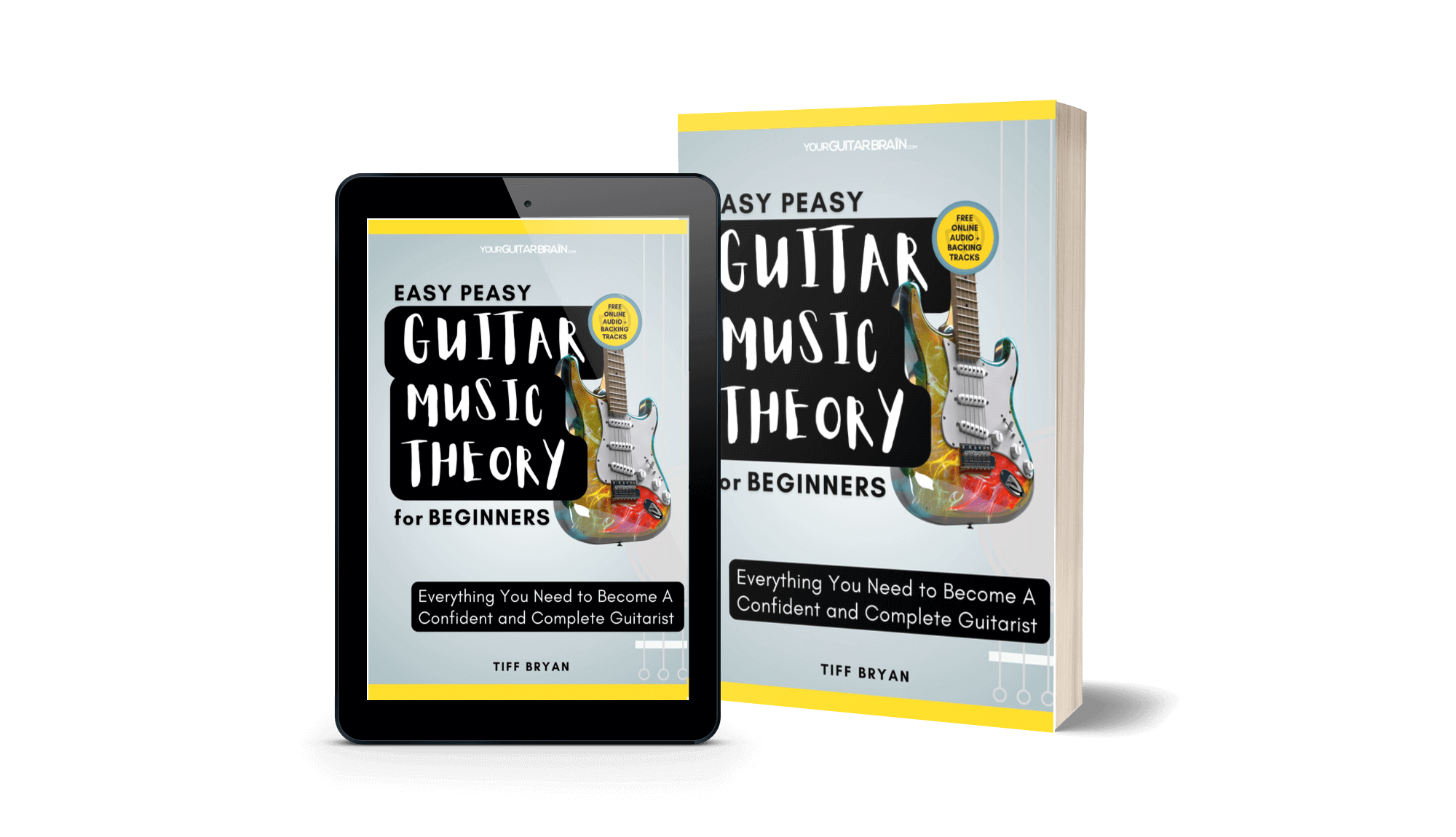Easy Peasy Guitar Music Theory: for Beginners Book Audio Resource Area

Hi! Welcome guitar player to the exclusive resource area to accompany the beginner music theory book Easy Peasy Guitar Music Theory: for Beginners. First, I want to say a huge thank you for buying the book.
I hope music theory is easier to understand for you now.
This page contains access to the bonus Beginner Guitarist Toolbox (scroll to the bottom of the page for access) plus the exercise audio clips that will help you get the most from the action exercises featured in the book.
How to Use This Page:
- Audio track exercises are labelled according to book chapter and exercise number. Simply scroll down and navigate to the desired chapter and audio track. Click to play.
- Most tracks are set to loop so you can jam away to your heart’s content.
- Don’t just visit once. The best way to improve your guitar playing and hear impressive results is to come back often to practice the exercises on this page. How long will it take for you to be able to play along smoothly to the faster tempo audio tracks for example?
- Have fun! You’re learning guitar to develop a new skill and have fun. Keep this top of mind throughout your journey and go for it.
Listen to The Audio Tracks
All the audio tracks are high-quality, mixed at 320kbps. The sound quality of the audio on your end will depend on the size and quality of your speakers.
Avoid playback through your smartphone or tablet speakers; pair them up with a decent Bluetooth speaker or good headphones.
Check out the following articles to discover the top guitar accessories currently on the market:

The Best Guitar Gadgets and Gifts for Guitar Lovers – 2024
Looking for unique, cool gadgets or gift ideas for a guitar lover? We have 15 crazy cool guitar accessories and gadgets for you to check out…

7 Best Tablets for Musicians (Performance + Practice) | 2024
Whether you’re after the best tablet for gigging, the best tablet for displaying sheet music or for general web browsing, we…
Chapter 4: Scales Made Simple
Fig 4.2 – 1-2-3-4 Spider Fingers Chromatic – 60bpm – 1/8th Notes (Quavers)
To achieve optimal results, shift the chromatic sequence up 4 semitones and position it as high up the neck as possible.
Once you feel comfortable, incorporate additional variations. For instance, you can try ascending and descending the notes or skipping strings.
Top Tip: Never stick to the same exercise variation, week in and week out. You need to challenge yourself and make it interesting to see results.
Fig 4.2 – 1-2-3-4 Spider Fingers Chromatic – 100bpm – 1/8th Notes (Quavers)
Fig 4.11 – C Major scale | Ascending and descending one-octave – 70bpm – 1/4th Notes (Crotchets)
Fig 4.11 – C Major scale | Ascending and descending one-octave – 130bpm – 1/4th Notes (Crotchets)
Fig 4.12 – C Major scale | Ascending and descending two-octaves – 70bpm – 1/4th Notes (Crotchets)
Fig 4.12 – C Major scale | Ascending and descending two-octaves – 130bpm – 1/4th Notes (Crotchets)
Chapter 8: Chord Progressions: Playing By Numbers
Exercise 1: Major chord progression jam tracks
This track features four chord progressions in the key of G major and uses the strumming pattern D/D/U/U/D/U. It is designed to loop seamlessly so you can practice along.
Top Tip: If you are new to playing and find it difficult to keep up with the chord changes, start by practicing with one downstrum on the first beat of every bar.
Once you feel comfortable, progress to one strum per beat. Your goal for the near future should be to play the complete strumming pattern along with the jam tracks provided below.
Remember, there are various methods to achieve your objective. 🙂
Audio performed & produced by Tiff Bryan.
Progression 1. I – IV – V | G – C -D |100bpm
Progression 2. I-V-vi-IV | G – D – Em – C | 100bpm
Progression 3. I-vi-IV-V | G – Em – C – D | 100bpm
Progression 4. ii–V–I | Am – D – G | 100bpm
Chapter 10: Chords In Minor Keys
Exercise 2: Minor chord progression jam tracks
The two minor chord progressions are played in the keys of Am and Em. Each track will loop for you to practice with.
Progression 1 (i-iv-v) uses this strumming pattern: D/D/D/D. Be sure to listen out for the dynamics used in the pattern rhythm.
Progression 2 (i-VI-III-VII) uses this strumming pattern: D/D/D/U/D/D.
Progression 1. i-iv-v in E minor | Em – Am – Bm | 70bpm
Progression 1. i-iv-v in A minor | Am – Dm – Em | 70bpm
Progression 2. i-VI-III-VII in E minor | Em – C – G – D | 70bpm
Progression 2. i-VI-III-VII in A minor | Am – F – C – G | 70bpm
Chapter 12: Pentatonic Scales
The following 5 minor pentatonic scale patterns are being played in eighth notes in 2 x tempos:
40bpm with 2 picks per click is equivalent to 80bpm with quarter notes at 1 pick per beat. 70bpm with 2 picks per click is the same as 140bpm quarter notes with 1 pick per click.
Fig 12.1 – A minor pentatonic Pattern 1 (A root) – 40bpm – 1/8th notes (quavers)
Fig 12.1 – A minor pentatonic Pattern 1 (A root) – 70bpm – 1/8th notes (quavers)
Fig 12.2 – A minor pentatonic Pattern 2 (C root) – 40bpm – 1/8th notes (quavers)
Fig 12.2 – A minor pentatonic Pattern 2 (C root) – 70bpm – 1/8th notes (quavers)
Fig 12.3 – A minor pentatonic Pattern 3 (D root) – 40bpm – 1/8th notes (quavers)
Fig 12.3 – A minor pentatonic Pattern 3 (D root) – 70bpm – 1/8th notes (quavers)
Fig 12.4 – A minor pentatonic Pattern 4 (E root) – 40bpm – 1/8th notes (quavers)
Fig 12.4 – A minor pentatonic Pattern 4 (E root) – 70bpm – 1/8th notes (quavers)
Fig 12.5 – A minor pentatonic Pattern 5 (G root) – 40bpm – 1/8th notes (quavers)
Fig 12.5 – A minor pentatonic Pattern 5 (G root) – 70bpm – 1/8th notes (quavers)
Fig 12.8 – Identical patterns, different pitch centres: C major pentatonic & Am pentatonic. scales – 65bpm – 1/8th notes (quavers)
Chapter 13: Blues Scales
Fig 13.2 – A minor blues scale Pattern 1 – Ascending and descending over 2 octaves – 70bpm
Fig 13.6 – E major blues scale Pattern 1 – Ascending and descending over 2 octaves – 70bpm
Exercise 1: 12-bar blues progression in A
Mix and match the A minor pentatonic scale and A blues scale over the following A7-D7-E7 progression as per the instructions in the book. (Track is set to loop.)
Exercise 2: 12-bar blues progression in E
Mix and match the E minor pentatonic scale and E blues scale over the following E7-A7-B7 progression as per the instructions in the book. (Track is set to loop.)
A Minor Blues Scale Licks x 2.
Follow the tablature in the book and listen to the phrasing of these two Am blues licks. They fit perfectly over Exercise 1 blues progression in A track.
➡️ Best Guitar Lessons & Online Music Courses
Discover the best online guitar tutorial apps and music courses for beginners upwards to fast-track your musical gains!
JamPlay Check it out >>
TrueFire Check it out >>
Pickup Music Check it out >>
Coursera Check it out >>
Bonus Area: “Beginner Guitarist Toolbox”
Get access to your premium free “Beginner Guitarist Toolbox” bonus downloads here! These tools will make your journey on the guitar breezier. What you get:
Essential Beginner Chords Poster – Featuring 35 of the most used chords + bonus Guitar Fretboard Notes Chart (high res)
- Blank Fretboard – handy practice tool for you to print out and write on
- Blank Tablature Sheets – to quickly create your own TABs hassle-free
- Blank Practice Planner x 2 – printable weekly and daily guitar practice schedules to make your practice sessions super productive
N.B. If you have any trouble downloading the bonus below, please don’t hesitate to email me at info@yourguitarbrain.com, and I will make it right ASAP.
Note: By signing up, you also agree to go onto our mailing list. We never send you annoying junk, just the occasional email with guitar-related tips and news we think you’ll dig. Easily unsubscribe from within the email anytime.


